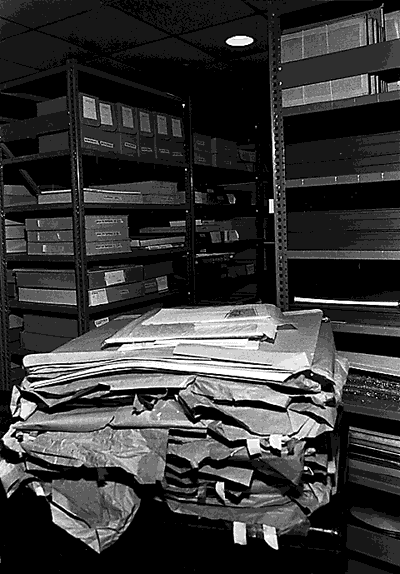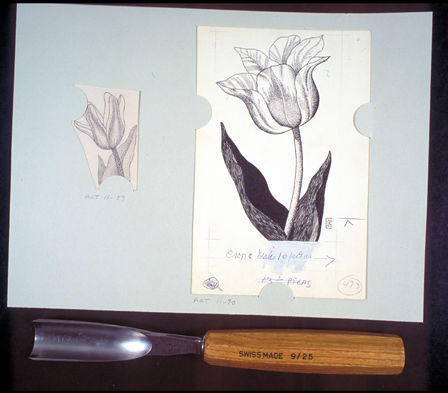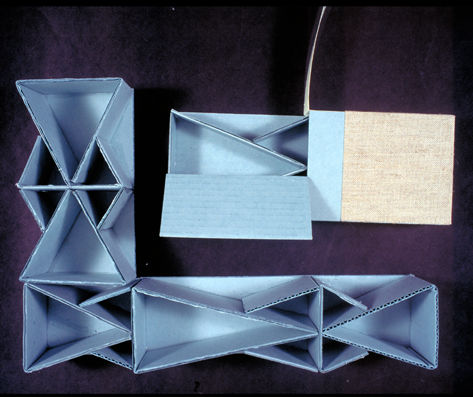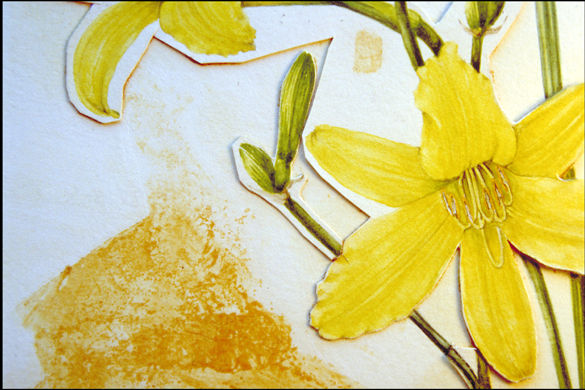Art Serving Science: Solutions for the Preservation and Access of a Collection of Botanical Art and Illustration
Judith Reed, Olga Souza Marder, and Laura McCannIntroduction
In the early 1990s, the Library of the New York Botanical Garden diversified its preservation efforts to respond to challenges brought about by growth of its book and special collections and by institutional planning. A plan was under way to the construct a new Plant Studies Center to house the Library and Herbarium1 collections in a state-of-the-art storage facility.
The Library's conservation department initiated preservation projects for the special collections. These projects reflect the basic tenets guiding the Library's preservation efforts: to provide long-term stable storage and easy access to its collections. The Art and Illustration Collection was one of the first special collections selected for preservation.
The Art and Illustration Collection was accumulated by the Library from numerous sources. The collection continues to grow, as artists donate their works, Garden scientists and the NYBG Press deposit original illustrations used in their publications, and as pieces of original art found in the Garden's archives are added to the collection. At this time the collection contains about sixty individual collections with an estimated total of 15,000 items. It includes a variety of media, such as pen and ink drawings and watercolor paintings, most of which were used to illustrate scientific publications and popular works of science. The art was executed between the early nineteenth century and the present.
Historical Background Of Botanical Art
Fig. 1a. Heinrich Füllmaurer and Albrecht Meyer are depicted in the earliest known portrait of scientific illustrators. Reproduced from: Leonhardt Fuchs, De Historia Stirpium..., Basileae: In Officina Isingriniana, 1542.
Fig. 1b. Botanical artist working in the field in French Guiana (1992). Photograph credit: Carol Gracie.
To place modern scientific illustration into historical perspective, one must understand that collaborations between botanists and artists came about when Renaissance naturalists realized the need for accurate illustrations drawn from nature to depict their new discoveries. The earlier tradition of copying ancient words and pictures did not fit the needs of the Renaissance. A new collaboration developed amongst naturalists, artists, and draftsmen, bringing art and science together, as is true today (figs. 1a-b).
Botanical art must be accurate to be scientifically valid, but can be beautiful, if executed by a talented and informed artist. Scientific botanical art is generally intended to be published and used by botanists in their research. According to some botanists, a well-drawn illustration is often more effective than a photograph for conveying diagnostic characteristics and the overall likeness of the species. The drawing should inform and elucidate beyond what is described in words. Botanical art depicts information that the viewer easily recognizes without needing to understand or translate the text.
From the Renaissance to the present, producing an illustrated book has been time-consuming and expensive. It was common practice for Renaissance printers to use the same wood blocks over again, often renting or buying them from another publisher. Reuse of botanical illustrations is common practice to this day and explains the need for the botanical community to have ready access to the drawings. It will also clarify conservation concepts and solutions adopted for this project.
Development Of the Preservation and Access Plan
In 1994, the conservation staff directed its efforts toward developing a conservation plan for the Art and Illustration Collection. Goals of the project were to physically stabilize individual pieces of art; provide secure and permanent housing for the collection before its move to the new storage facility; provide better access to materials; and refine the long-term preservation plan for the collection.
Fig. 2a & b. Storage conditions of botanical illustrations prior to rehousing project.
Initially, a collection level survey was carried out to evaluate general needs of the pieces within each collection. For the most part, the drawings have been executed on good quality watercolor paper, Bristol board, or drawing board. Most media—graphite, black ink, and watercolor—appear to be quite stable. Prior to relocation to the Library, the collection suffered primarily from inadequate storage conditions and poor handling practices (figs. 2a-b). The damaging effects of aging adhesives used on tracing paper and composite publishing plates are commonly found in the collection (fig. 8).
 | 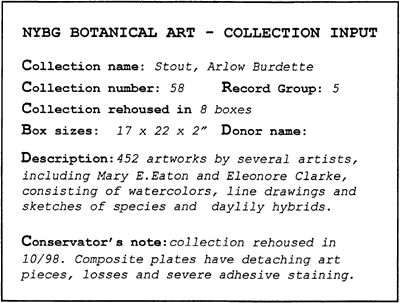
|
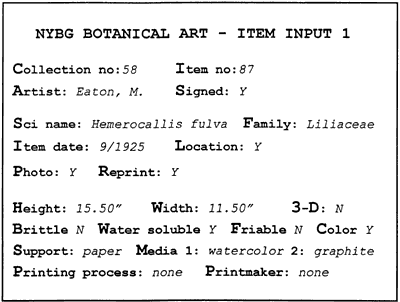 | 
|
Fig. 3. Search and input screens for NYBG Botanical Art Database.
The next step in the plan was to design a database.2 Initially seen as a survey tool for collecting and retrieving conservation information, the database evolved into a basic finding guide to the collection. Information on plant identification and artist as well as conservation needs for each piece are recorded (fig. 3). The database allows users to link the art to published works and archives in the Library and corresponding dried plant specimens in the Herbarium.
With the database in place, the conservation staff, through discussions with Library staff and conservation colleagues in other institutions, began to plan the stabilization and rehousing of the collection. Once the plan was drafted, a pilot project was conducted, during which time 1,500 pieces were processed. After the pilot project was completed, a plan was finalized, and has been implemented over the past six years.
The stabilization and housing plan consists of four components:
- Arrangement: Since the drawings are used primarily for research purposes, they are usually arranged, within each collection, by plant family, in the same manner as the dried plants in the Herbarium.
- Surveying and data entry: Each piece of art is surveyed for physical condition and conservation needs. This information is entered into the database along with the scientific plant name(s), artist, and publications in which the illustration appears.
- Cleaning and wrapping: The drawings are surface cleaned and wrapped in glassine paper. Only those problems requiring immediate intervention by a conservator are being treated during this phase of the project.
- Housing: Individually wrapped pieces are grouped together for placement into four-flap wrappers. Groups of wrappers are housed in standard-sized Solander boxes.3 Pieces of irregular size or shape are given special mounts or stored in alternative housing.
To accomplish this long-term project, the Library has been fortunate to supplement its small conservation staff with technicians funded with grants from the Institute for Museum and Library Services and conservation interns funded by the Samuel H. Kress Foundation. Research projects of the interns have helped provide solutions to particular conservation problems in preserving the collection.
Solutions: Techniques and Materials
Certain conservation techniques and materials were selected and developed because the collection is part of a scientific research library rather than an art museum. For example, storing drawings in mats is impractical because storage space is limited, and the works are seldom exhibited.
After reviewing possible wrapping materials to determine which would best protect the drawings, a pH neutral, lignin-free glassine paper was selected. This material is translucent enough to view the images without unwrapping them, reducing the risk of mechanical damage and soiling. It is lightweight, relatively inexpensive, has a non-abrasive surface, and does not have electrostatic characteristics. Although glassine is not particularly strong, that is not required for our purpose. Polyester film is used when physical strength is required to support fragile pieces with non-friable media.
Fig. 4a. Two different sized illustrations mounted onto Bristol board using tabs. Wood gouge shown below.
Fig. 4b. Illustration with several images cut from the plate, mounted onto Bristol board using tabs, in order to provide better support.
Since the drawings are usually arranged by plant family, pieces of varying sizes are often stored next to each other. To prevent their shifting and causing damage to one another, small pieces are mounted non-adhesively to supports made of lightweight Bristol board. The drawings are held in place by cutting tabs into the Bristol, using a woodworkers gouge4 (fig. 4a). When possible, several small pieces are mounted to the same sheet, saving storage space. Experience at NYBG showed that pre-made polyester film corners with adhesive applied to the very edges risked adhesive "ooze" and possible damage to the drawing. Preparing polyester film or paper corners in-house was too time-consuming to be practical.
Among the specific problems encountered were numerous illustrations from which individual images had been cut for preparation of publication plates. This left large areas of loss, which caused the support to be unstable and difficult to handle. In other cases the drawings had been cut into individual images, resulting in a series of tiny drawings, with no clue as to which ones originally belonged together in the same plate.
The problem of supporting drawings with images cut from them was solved by using a modification of the tab system described earlier. Tabs can be cut into any area on the Bristol board support to stabilize a weakened part of the drawing (fig. 4b). For storage of the small drawings, many of which are somewhat fragile, polyester film pockets were prepared, using a Crossweld heat-sealing machine. A piece of buffered paper was placed behind each drawing. If information was written on the verso, it was photocopied onto the buffered paper.
While the tab system has proved effective for consolidating items with large losses, a different system was needed for supporting a group of illustrations with extensive insect damage. A number of nineteenth-century drawings of the flora of Cuba were added to the collection after being stored for many years in poor housing under tropical conditions. The images, executed with a variety of media on lightweight paper, had suffered severe insect damage and had been fumigated with an unidentified product before coming to the Library.
Fig. 5. Fragile illustration with insect damage from the Flora Cubana collection, encapsulated between polyester film and polyester webbing.
In this case polyester film appeared to be the most appropriate material to support these drawings. However, there was concern with having polyester film on both sides of the drawings. The solution was to use polyester film on the front, heat-sealed to polyester webbing on the back, allowing the drawings to breathe. Sheets of buffered paper were placed behind them. For purposes of efficient storage and production, the polyester film and webbing were cut to a standard size. To keep the varying sized drawings from shifting within the enclosures, each was sealed close to the edges of the drawing (fig. 5).
Once the drawings were surface cleaned with Mars-Staedtler eraser crumbs and individually wrapped, they were grouped together into four-flap wrappers one-half inch thick. This prevents the artworks from shifting within their final enclosure and allows for easier and safer handling. Since strength is not a major issue, ten-point buffered Bristol board is sufficient.
Fig. 6a & b. Solander boxes with fillers.
Fig. 6c. Illustrations for construction of corrugated board fillers. Drawings by Martha A. Fitzpatrick.
Fig. 6d. Corrugated board models showing filler construction.
Fig. 7. Storage condition of botanical illustrations after rehousing.
A decision was made to construct double-wall Solander boxes as the final housing for the artwork.5 They are sturdy and are commonly used for housing materials in libraries. Pre-made archives storage boxes proved not to be sturdy enough for long-term storage. For orderly shelving, the boxes are made in two sizes. These sizes were determined to accommodate the bulk of the artwork, while fitting properly on the shelving in the collection storage area in the new Plant Studies Center.6 The half size boxes are designed to stack side-by-side on top or below larger boxes. In this way the weight is evenly distributed and supported along the sturdy outer walls, avoiding structural distortion to the boxes themselves (fig. 7).
In order to accommodate the varying sizes of the artworks and to keep them from shifting around, the interior of the boxes are modified. Fillers are made of buffered corrugated board, with honey-comb structures, to avoid making the boxes too heavy. These fillers are covered with the same material as the boxes.7 When two different sizes of wrappers must be stored in the same box, a stepped filler is constructed (figs. 6a-d).
Included in the artwork are a number of pieces too large to fit into the larger size Solander boxes. Since it is impractical to construct and carry boxes any larger than the 17 x 22 inch, another storage option was needed. Flat files are in common usage in the Library and lent themselves to a satisfactory solution. As with the materials stored in the boxes, these larger pieces are first wrapped in glassine paper, mounted on Bristol board when necessary, and enclosed in four-flap Bristol board wrappers with labels. To keep the wrappers from shifting within the drawers, dividers and wedges, made of corrugated board, are constructed and placed in the drawers to serve the same purpose as the fillers in the boxes.
Spine labels for both wrappers and boxes are computer-generated. They are very legible, allowing for quick access and ensuring that artwork will be returned to proper enclosures and reshelved in correct order. When the artwork supplements a scientist's research papers, which are a part of the Library's archives collection, the label also includes information linking the art to its archives record group.
Future Directions
Fig. 8. Detail of illustration showing adhesive residue and staining, left after one drawing from a composite plate detached, due to adhesive failure.
One continuing conservation issue involving the collection concerns the different adhesives used to make composite publishing plates. The problems are many-fold: adhesive identification, adhesive failure, adhesive residue, and the question of still-active chemicals in the adhesives (fig. 8). In most instances removal of adhesive stain is less urgent for our collection than for a frequently exhibited collection. Rather, it is necessary to know whether a detached image can be re-adhered, or if the first adhesive will prevent reattachment.
Fig. 9. Composite publishing plate with notations for printer. The plate includes both watercolor paintings and hand-colored photographs.
This task is more complicated considering that these publishing plates may have not been designed by the artist who executed the drawings (fig. 9). In such situations, should an attempt be made to re-adhere individual images that have detached? If the composite plate is unpublished, where should the cut-out drawing be re-adhered? If the image is not reattached, how can it be kept with the plate, for historical information purposes? There are also composite publishing plates, which are comprised of both photostat images from previous published works and original drawings.
Conclusion
Substantial progress on the preservation of the botanical art collection has been made over the past six years. Over 9,000 art works have been surveyed, stabilized and rehoused. The botanical information recorded in the database provides access for library users. The database will be invaluable in the future, particularly when conservation treatment is to be carried out on the artwork. The staff can retrieve information on which pieces are in need and what level and kind of treatment is required.
Acknowledgments
The authors have had help and cooperation from colleagues in the field of conservation, fellow staff members in the Library, and the New York Botanical Garden's scientists and publications staff, in both long-range planning and ideas for solving specific conservation problems. We are grateful to all of those individuals for their willingness and generosity in sharing with us their expertise and experience.
A rich interchange occurred between the Library's conservation staff and Garden scientists who collaborated not only in properly identifying the plants, but also in helping the conservators to understand the need and value for graphic documentation for the science of botany.
Special thanks goes to "the team" that contributed directly to the project: Andrea Winona Abraham, Bernadette Callery, Jacalyn H. Chin, Martha A. Fitzpatrick, Susan Fraser, Kelsey Osborn, Kelli Piotrowski, John F. Reed, Erin Vigneau, Muriel Weinerman, Dr. Thomas Zanoni, and the Samuel H. Kress Foundation.
Unless otherwise noted, all photographs were taken by NYBG staff photographer Muriel Weinerman.
Notes
1. The NYBG Herbarium holds a collection in excess of six million dried and pressed plant specimens, filed by an accepted system used for botanical research and study. Herbarium staff carry out preservation of the specimens following techniques that have been developed over many years, using sound contemporary materials.
2. The database, developed for the Botanical Art Collection by a former Library staff member, used dBase IV 2.0 software. Discussions are currently under way with Garden's Computer Service's staff and vendors to upgrade and make the database compatible with CATALPA, the Library's online catalog.
3. Solander boxes are known alternately as drop-spine boxes, clamshell boxes, or double-tray boxes.
4. Conservator Hedi Kyle at the American Philosophical Society has used a woodworkers gouge for various conservation projects. An NYBG conservation intern, observing this technique, adapted its use to the NYBG project.
5. Using Solander boxes for storage of the NYBG botanical art is fitting, since the original design of this style of enclosure is attributed to Dr. Daniel Charles Solander, an eighteenth century botanist. Dr. Solander was keeper of natural history collections and librarian at the British Museum and took part in Captain Cook's first voyage around the world. The boxes were devised for the storage of drawings and botanical specimens collected on that voyage. Boxes of this design are still in use in the libraries at Kew Royal Botanic Gardens and the British Natural History Museum to house their art collections and some herbarium specimens.
6. The measurements of the standard size Solander boxes adopted in this project are (in inches): 17 x 22 x 2; 17 x 22 x 1; 11 x 17 x 2; and 11 x 17 x 1.
7. These sturdy lightweight fillers, an adaptation of a traditional bookbinder's technique, were developed by the NYBG conservation staff and Martha A. Fitzpatrick, a former Kress Intern.
Judith A. ReedConservation Librarian
The New York Botanical Garden
Olga Souza Marder
Conservator
The New York Botanical Garden
Laura T. McCann
Conservator
Brooklyn, New York
Publication History
Received: Fall 1999
Paper delivered at the Book and Paper specialty group session, AIC 27th Annual Meeting, June 8-13, 1999, St. Louis, Missouri.
Papers for the specialty group session are selected by committee, based on abstracts and there has been no further peer review. Papers are received by the compiler in the Fall following the meeting and the author is welcome to make revisions, minor or major.


